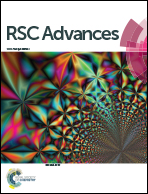NIR transmittance tuneability under a magnetic field of colloidal suspensions of goethite (α-FeOOH) nanorods
Abstract
Goethite (α-FeOOH) nanorods have been synthesized using two different methods, by aging at different temperatures of ferrihydrite suspensions obtained through co-precipitation, or by fast conversion of ferrihydrite through ultrasonic irradiation. The synthesis method and parameters influenced the size and shape of nanoparticles. Stable colloidal suspensions of nanorods have been prepared by purification of the precipitates and subsequent dispersion in deionised water by sonication. The synthesized nanopowders have been characterized by Powder X-ray Diffraction and Scanning Electron Microscopy and the colloidal suspensions by Dynamic Light Scattering and ζ-potential measurements. The magnetic field at nuclei level has been investigated by Mössbauer spectroscopy. Moreover, since a colloidal suspension of goethite is a mineral liquid crystal and due to its peculiar magnetic properties, polarized radiation transmittance of colloids in the UV-vis-NIR range has been determined under different magnetic field directions and intensities. It has been found that the transmittance in the NIR range can be tuned by changing magnetic field direction and strength.



 Please wait while we load your content...
Please wait while we load your content...